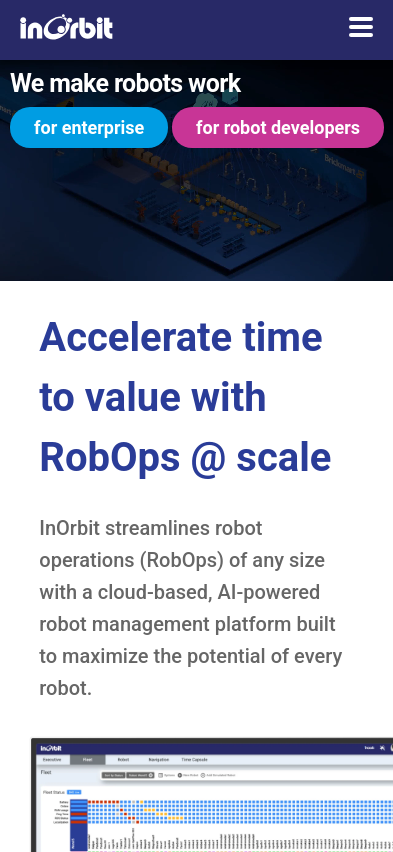⚡ZurzAI.com⚡
AI Start Ups Your Should Know
InOrbit AI

InOrbit AI delivers large-scale enterprise AI solutions for designing optimized layouts in industrial settings, including warehouses, ensuring minimal travel distances and optimized picking routes.
About | Leadership | Leadership | Leadership | About | Management | About | News | News | About | About | News | News | News | About | News | News | About | News | News | News | About | News | News | About | News | News | News | About | News | About | News | News | About | About | News | About | About | About
InOrbit is a cloud-based, AI-powered robot management platform aimed at optimizing robot operations (RobOps) of various scales. The platform facilitates the smooth deployment, operation, and management of robot fleets through a range of interoperable tools, processes, and practices that streamline robot operations, providing a comprehensive solution for both enterprise users and robot developers.
Key Features of InOrbit:
-
RobOps Platform: InOrbit offers a standardized platform that simplifies the management of robot fleets across different sites and from various vendors. It includes tools for integration, orchestration, performance analytics, and the resolution of autonomy errors.
-
AI and Robot Data Insights: The RobOps Copilot allows users to gain insights from robot data using natural language queries, facilitating better decision-making through AI.
-
Integration Capabilities: The platform integrates seamlessly with existing systems like Warehouse Management Systems, Enterprise Resource Planning, and more. It also supports standards like VDA 5050, enhancing multi-vendor interoperability.
-
InOrbit Missions: This feature allows users to define, execute, and analyze robot fleets' missions, focusing on performance and traffic management, supporting the orchestration across various vendors.
-
Real-Time Location Services (RTLS): InOrbit integrates RTLS to track not just robots, but also manual machines and personnel, enhancing operational visibility and safety.
-
Simulator Integration: For developers, simulations are available through NVIDIA Isaac Sim™, which helps in workflow improvement and mitigation of potential issues before deployment.
Support for Robot Developers:
For robot developers, InOrbit provides a robust platform through which developers can manage robot operations efficiently:
-
Developer Support: Developers can integrate InOrbit’s functionalities through APIs and customization options, creating tailored solutions for robot management.
-
Incident Management: Tools for resolving autonomy incidents are available, helping reduce downtime through advanced analytics and video integrations.
-
InOrbit Connect Certification: A certification program that ensures interoperability across different robots and systems, thus streamlining integration processes.
-
Customization Tools: Developers can create custom dashboards and user interfaces with widgets and embeds, enhancing the operational experience.
Community and Ecosystem:
-
InOrbit Robot Space: Located in Mountain View, the InOrbit Robot Space serves as a community hub and showroom where individuals can experience the platform in action, see robots work in real environments, and participate in events and educational workshops.
-
Open Source and Standards Commitment: InOrbit shows a commitment to open-source standards and supports initiatives like the Robot Operations Group (ROG), promoting interoperability and collaboration across the robotics community.
Pricing and Editions:
-
Editions: InOrbit offers different service tiers, including a Free Edition for enthusiasts and small fleets, Standard Edition with additional functionalities, and Enterprise Edition for large-scale operations with advanced support options.
-
Financial Accessibility: A Software-as-a-Service model with flexible pricing to accommodate scaling operations and a free tier to encourage early-stage companies to adopt robotic technologies without significant upfront investment.
Educational Resources:
- Library and Blog: InOrbit provides a library of whitepapers, case studies, webinars, and a dynamic blog to keep users informed about the latest trends and practices in robotics operations.
In conclusion, InOrbit facilitates robotic operations by offering a scalable platform that supports efficient robot fleet management, interoperability, and integration into existing business infrastructures. The platform's focus on AI, data insights, and user-friendly operations helps businesses and developers optimize their robotic capabilities effectively.